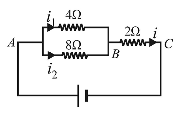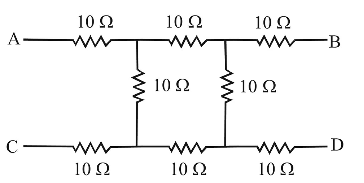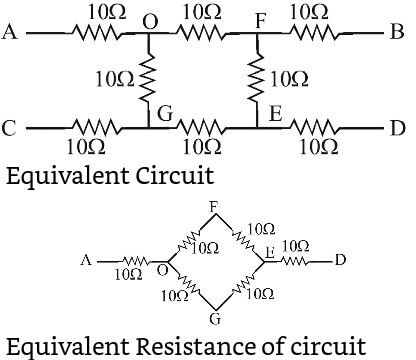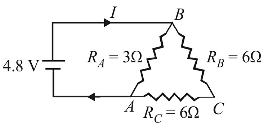Current Electricity
- In the circuit shown in Fig, the current in 4 Ω resistance is 1.2 A. What is the potential difference between B and C.

-
View Hint View Answer Discuss in Forum
The potential difference across 4Ω resistance is given by V = 4 × i1 = 4 × 1.2 = 4.8 volt
So, the potential across 8Ω resistance is also 4.8 volt.Current i2 = V = 4.8 =0.6 amp 8 8
Current in 2Ω resistance i = i1 + i2
∴ i = 1.2 + 0.6 = 1.8 amp
Potential difference across 2Ω resistance
VBC = 1.8 × 2 = 3.6voltsCorrect Option: A
The potential difference across 4Ω resistance is given by V = 4 × i1 = 4 × 1.2 = 4.8 volt
So, the potential across 8Ω resistance is also 4.8 volt.Current i2 = V = 4.8 =0.6 amp 8 8
Current in 2Ω resistance i = i1 + i2
∴ i = 1.2 + 0.6 = 1.8 amp
Potential difference across 2Ω resistance
VBC = 1.8 × 2 = 3.6volts
- Two wires of the same metal have same length, but their cross-sections are in the ratio 3:1. They are joined in series. The resistance of thicker wire is 10Ω. The total resistance of the combination will be
-
View Hint View Answer Discuss in Forum
Length of each wire = l; Area of thick wire (A1) = 3A; Area of thin wire (A2) = A and resistance of thick wire (R1) = 10 Ω.
Resistance (R) = ρ l ∝ 1 (if l is constant) A A ∴ R1 = A2 = A = 1 R2 A1 3A 3
or, R2 = 3R1 = 3 × 10 = 30 Ω
The equivalent resistance of these two resistors in series
= R1 + R2 = 30 + 10 = 40Ω.Correct Option: C
Length of each wire = l; Area of thick wire (A1) = 3A; Area of thin wire (A2) = A and resistance of thick wire (R1) = 10 Ω.
Resistance (R) = ρ l ∝ 1 (if l is constant) A A ∴ R1 = A2 = A = 1 R2 A1 3A 3
or, R2 = 3R1 = 3 × 10 = 30 Ω
The equivalent resistance of these two resistors in series
= R1 + R2 = 30 + 10 = 40Ω.
- What will be the equivalent resistance of circuit shown in figure between two points A and D

-
View Hint View Answer Discuss in Forum

= 10 Ω + 20 × 20 + 10 = 10 + 10 + 10 = 30 Ω 20 + 20
Correct Option: C

= 10 Ω + 20 × 20 + 10 = 10 + 10 + 10 = 30 Ω 20 + 20
- The current in the following circuit is

-
View Hint View Answer Discuss in Forum
Resistance of ACB, R' = 3Ω + 3Ω = 6Ω.
For net resistance between A and B; R' = 6Ω and 3Ω are in parallel.RAB = 3 ×6 = 18 = 2 Ω 3 + 6 9 Current in circuit (I) = E = 2 = 1 A RAB 2
Correct Option: A
Resistance of ACB, R' = 3Ω + 3Ω = 6Ω.
For net resistance between A and B; R' = 6Ω and 3Ω are in parallel.RAB = 3 ×6 = 18 = 2 Ω 3 + 6 9 Current in circuit (I) = E = 2 = 1 A RAB 2
- The current (I) in the given circuit is

-
View Hint View Answer Discuss in Forum
In circuit, RB and RC are in series, so, Rs = 6 + 6 = 12 Ω.
This 12 Ω resistance is in parallel with RA = 3 Ω,
So, equivalent resistance of circuitR = 3 × 12 = 36 = 12 Ω 3 + 12 15 5 ∴ Current in Circuit, I = V R 
Correct Option: B
In circuit, RB and RC are in series, so, Rs = 6 + 6 = 12 Ω.
This 12 Ω resistance is in parallel with RA = 3 Ω,
So, equivalent resistance of circuitR = 3 × 12 = 36 = 12 Ω 3 + 12 15 5 ∴ Current in Circuit, I = V R 

